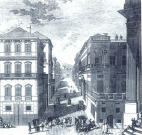

Strada Balbi
In the late 1500s, Stefano Balbi proposed to the Genoese government a new street, in what is now Genoa's old city. He committed to financing the street and proposed naming it Via Balbi (pictured at left, viewed from Piazza dell' Acuqaverde).
Ultimately, the proposal to bring the street from the garden of the Pallavicino to the Piazza of Vestado was approved. This route would be the least disruptive, since there were only seven small houses in its path. In March 1602, the government commission proposed new taxes on houses, an evaluation of parcels, and held discussions with the owners of the seven houses. It took three years to get the street approved.
In 1605 Stefano signed an agreement to buy the seven houses, demolish them, and pay for the street. In addition, in order to service the palaces, the irrigation system needed to be enlarged. Stefano offered to pay for the cost of the new system, asking in return that he be given oversight for construction of the road.
In 1646 the Senate approved the license to pave the street. The construction of the Via Balbi was a long, complex and costly project that included two work suspensions. It was finally completed in 1655, after Stefano's death. His son, Giovan Battista completed the project.
Today Via Balbi is part of old Genoa where the Balbi family palaces still exist. They house the Palazzo Reale and University of Genoa facilities.

Via Balbi, viewed
from Piazza Dell' Acuqaverde

Via Balbi, viewed
from Piazza della Nunziata
 English
English Italian
Italian Spanish
Spanish